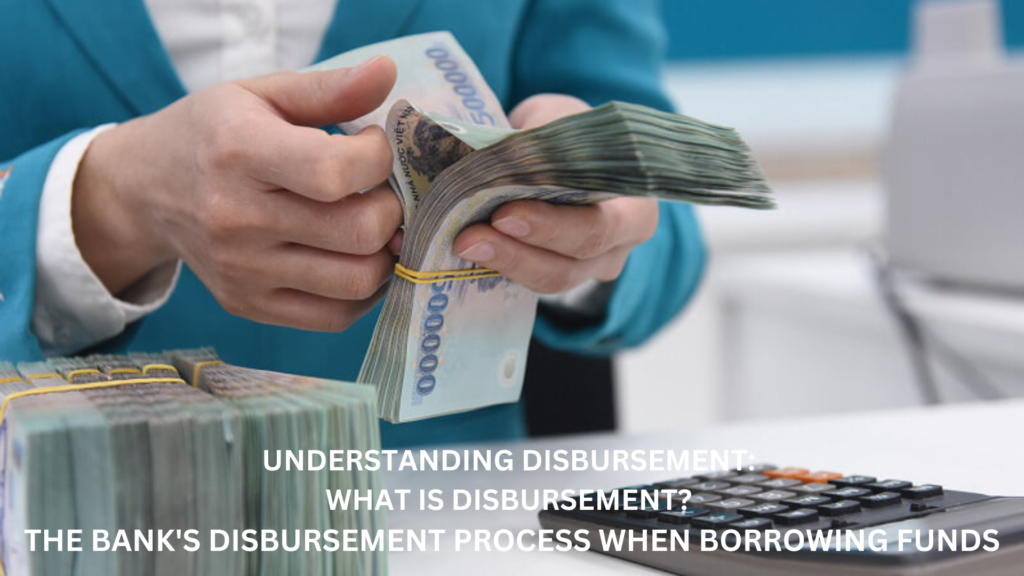What is disbursement? What is the specific disbursement process at the bank? What documents are needed during the disbursement process? These are questions that many customers are concerned about when borrowing funds from banks and financial institutions.
Understanding this, the article below by TOPGOVN will answer all these questions in detail and specifically. Let’s take a look together!
What is Disbursement?
Disbursement is a familiar term often used in the field of banking and finance. Disbursement means that the bank or financial institution transfers the amount according to the contract that the customer has previously registered for a loan.
In other words, disbursement is allocating an amount of money according to the contract signed between the customer and the lender. Depending on the need to receive money online or in person, the lending unit will proceed to release the funds after completing the loan procedures.
Based on the agreed contract, disbursement can be carried out once or multiple times.

Current Forms of Disbursement
Currently, banks and financial institutions are implementing two main forms of disbursement:
- Blocked DisbursementBlocked disbursement is applied in cases where customers need to borrow money for consumption purposes: purchasing real estate, cars, electronics, goods, etc. The disbursed amount will be used to complete the purchase of goods but cannot be withdrawn immediately after disbursement.Blocked disbursement is considered a safe form of disbursement for both the lender and the customer. Applying blocked disbursement helps the bank avoid losing the loan amount, and the borrower can still use the loan with full legal documentation, easily registering the asset ownership transfer.
- Unblocked DisbursementUnblocked disbursement is a form of disbursement where after borrowing, customers can immediately withdraw money from the account to spend. Unblocked disbursement is commonly used in unsecured loans, ranging from 10 to 500 million in a quick and convenient manner.Unblocked disbursement is often applied at some branches, banks, and financial units for small loans. Due to the high risks associated with this form, some banks require verification of the ability to transfer ownership and customers may need to pay an additional fee to get the disbursement.
Documents Required for Loan Disbursement
To get a loan disbursed, customers need to prepare the following documents:
- Legal Documents: Including ID card/passport, marriage status certificate.
- Income Proof Documents: Labor contract, salary slip, salary statement, appointment decision, business registration license, sales invoices, documents proving income from rental assets, etc.
- Documents Proving the Purpose of Fund Use: Deposit contract, purchase contract, payment notice, cost estimation documents, future capital needs, financial statements, etc.
- Documents Proving Asset Ownership: Red book/pink book, vehicle registration if the collateral is a car, etc. Additionally, ID card and household registration book if the asset belongs to a third party.
The Bank’s Loan Disbursement Process
The essence of the bank’s disbursement process is the loan process. Below is the detailed disbursement process you can refer to:
- Loan Registration and Information VerificationBefore proceeding with the loan, you need to declare the necessary information at the bank, including personal information, the purpose of using the loan, repayment ability, collateral, etc. Then, the bank staff will receive and verify the information provided by the customer.
- Document PreparationThe bank will give requirements for documents and procedures, which you need to prepare carefully and accurately. This is the decisive factor to confirm whether you are eligible for a loan. The required documents have been shared in the above part of the article.
- AppraisalAfter the customer provides the required documents, the credit officer will review, compare, and verify the information. If additional documents are needed, you will be asked to supplement them to complete the process.
- Loan ApprovalIf your information meets the bank’s criteria, the higher authority will proceed with the approval. Based on the provided information, the loan can be approved or denied and the customer will be notified.
- Loan DisbursementAfter the loan is approved, you will be disbursed the agreed amount in the contract. Depending on the loan case, the loan can be disbursed once or multiple times.

Important Notes When Completing Disbursement Procedures
When completing disbursement procedures, customers need to pay attention to the following issues to ensure the loan is quickly and safely disbursed:
- Always provide complete and accurate information as required to expedite the appraisal process.
- Schedule a visit to the bank according to the registered time to facilitate the procedures.
- Research the loan information thoroughly before signing the loan contract.
- Study and choose a loan that fits your financial capacity to ensure repayment ability.
Basic Terms in Disbursement
After understanding what disbursement is, you need to understand some basic terms in disbursement as follows:
- Disbursement Room: The lending limit of the bank or a certain credit institution.
- Cumulative Disbursement: The total amount disbursed over a certain period, aggregated.
- Disbursement Operation: The entire process where customers complete the disbursement conditions for financial units to disburse the loan funds.
- Disbursement Conditions: The process where the lending unit decides to disburse when the customer has met all the loan requirements, with reasonable and solid grounds.
- Funds for Disbursement: Derived from the decision to allocate the capital source.
- Beneficiary: The customer receiving the money.
- Money Manager: The unit that receives the order to release funds, transferring money to the beneficiary according to the disbursement decision.
- Blocked and Unblocked Disbursement: The two most common forms of disbursement today. Blocked disbursement is more widely applied in lending activities.
Conclusion
Above is the information to answer the question of what disbursement is, and the detailed disbursement process. Hopefully, with the shared information, you will make a decision to borrow funds and the disbursement process will proceed smoothly as expected. Wishing you success!
